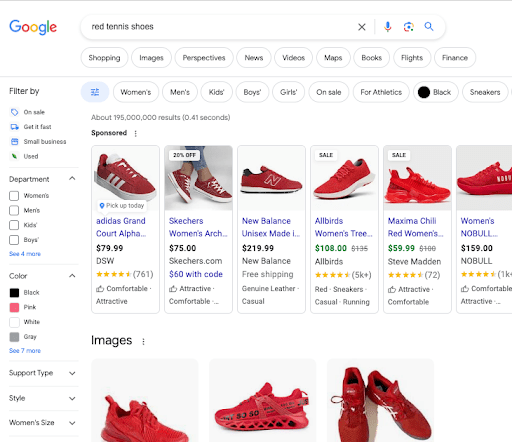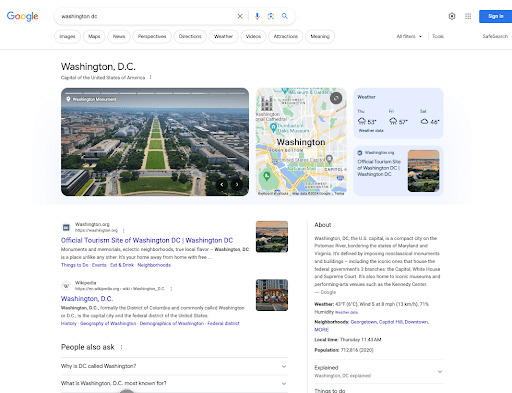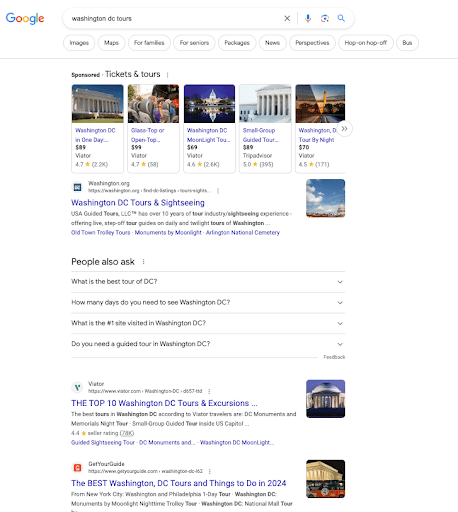

Updated May 7, 2025
SEO is always evolving, but generative AI has sped up this process exponentially. Learn how AI is impacting search results and what SEO strategies you can implement to remain competitive in SERPs.
Generative AI has changed organic search for good.
Between the incorporation of natural language processing (NLP) and machine learning in search algorithms, the introduction of AI chatbots like ChatGPT and Bard, and new search features like visual search, it’s becoming harder and harder for websites to rank organically.
Looking for a SEO agency?
Compare our list of top SEO companies near you
To remain competitive, you may need to adjust your content and SEO strategy. Here are a few tips to keep your business on the cutting edge:
Need help optimizing your website? Connect with industry-leading SEO agencies on Clutch.
Thanks to natural language processing and machine learning, search engines understand the nuances of phrases, synonyms, and interconnected concepts rather than relying on the presence of specific words or phrases. This is known as semantic search.
For instance, a query for “red sneakers,” “red tennis shoes,” and “red running shoes” would likely yield very similar results.

The goal of semantic search is to provide more accurate and more relevant results, providing a better experience for users. Believe it or not, this actually benefits your business — by providing relevant content, you can increase engagement on your website and increase time spent on the page.
This means that in order for pages to rank, you need to focus on the context surrounding a query, not just the keyword or phrase itself.
According to Search Engine Land, one of the best ways to achieve this is by creating an entity-first SEO strategy. The goal here is to provide comprehensive content to search queries — consider how you can answer all of the questions users are searching for.
For the red sneaker example, you may want to include information like prices, brand names, or store locations where users can buy them.
For more complex ideas, many content strategists use topic clusters to help search engines understand the context and relevance of the content, ultimately improving the website's authority on the topic.
Topic clusters are a content strategy where a pillar page serves as the main hub of content for a specific topic, and subtopic content pages are linked to the pillar page and to each other. This also provides a better user experience by guiding visitors to relevant content and keeping them engaged on the website.
Looking to hire an SEO company but aren’t sure how much it costs? Learn more about how much to budget in Clutch’s ‘SEO Pricing Guide.’
Launched in late 2021, Google’s BERT algorithm (the same algorithm update that brought semantic search to the forefront) uses natural language processing to understand search intent.
Search intent refers to the goal or motivation behind a user's online search query. It represents the specific information that the user is seeking when they enter a search term into a search engine.
So how do you know what a user’s search intent really is?
The best way to determine search intent is by looking at existing search results — you can often tell based on what is already ranking. Consider what types of content are ranking, their format, and angle.
Searching for “Washington DC” would show different results than even “Washington DC tours.” Here, you can see images from Washington, a map, weather, news, and tourism information.

With this, you can infer that search intent is informational — people are looking to understand more about the area. Consider how the search results would change if you were to search for a longer-tailed keyword like “Washington DC tours.”

Search results show bookable tours, showing that search intent is more purchase-driven.
For a new tour company, it would make sense for their pages that allow users to book a tour would appear on this search results page (SERP), but a long-form article about what tourists can do in DC would be more likely to appear on a SERP for “Washington DC.”
Understanding search intent is essential for creating and optimizing content that aligns with what users are looking for.
Structured data markup, also known as schema markup, is a standardized format for providing information about a web page and classifying its content in a way that is easily understandable by search engines.
Implementing schema markup can help improve the visibility and presentation of their content in search engine results pages. Moreover, schema markup helps search engines better understand the content of the page, which can lead to rich snippets or enhanced search results.
As search engines focus on providing more valuable content directly in search results, adding schema to capture enhanced search results will become even more important.
By using structured data markup, website owners can provide specific details about their content, such as product information, reviews, recipes, events, and much more.
To learn more about how you can implement schema markup to your website, you can visit schema.org. This site has a collection of schemas, or HTML code, that you can implement to your website, making it easy for you to reference.
With search engines like Google investing more and more in creating a search generative experience (SGE), brands need to optimize for these types of search results. Recently, search results have been showing video and other visual content more frequently.

Additionally, machine learning has allowed search engines to understand the contents of an image and match it with similar or related items, enabling search engines to create visual search features.
Visual search allows users to search online using images rather than text-based queries. So instead of typing a description of what they're looking for, users can upload an image or use a camera to capture a photo, and the visual search technology will analyze the visual elements within the image to provide relevant search results.
Whether you’re trying to optimize for visual search or hope to capture rich snippets, you will need to create high-quality visual content and invest in video production.
While you are probably familiar with optimizing your images for search, here are some tips to optimize your videos for search:
Using target keywords in video titles and descriptions
Learn more about how to optimize your videos for search here.
Some worry that Google’s search generative experience (SGE) and AI-based search engines like ChatGPT and Bard may reduce website clicks.
Unfortunately, with direct answers in search results, users are less likely to click to your website.
Not all is lost, though — capturing additional search features and being listed in AI-generated responses still provides value. Both can help companies increase their brand awareness and engagement with their website.
Still, digital marketers may see a dip in traffic and reduced click-through rates. To adjust to these changes, digital marketers will need to identify metrics that will showcase how their work is providing value. This can include:
By providing context for these shifts and tracking performance in new ways, digital marketers can secure support from key stakeholders like executives.
As any SEO specialist knows, search is always evolving. The recent introduction and emphasis on AI has only sped up this process. It’s a dynamic industry that requires companies to consistently adjust to stay up-to-date on best practices.
By embracing semantic search, prioritizing search intent, and creating high-quality visuals, companies can create valuable content for users. Combined with the implementation of optimization best practices, like schema markup, their website will thrive.
While optimizing your site for how AI has impacted search can help performance, you may still see declines in traffic simply because of search trends. When this happens, be sure to communicate how your SEO and content efforts are still providing value to the business. Highlight other metrics that can speak to your website’s performance.


